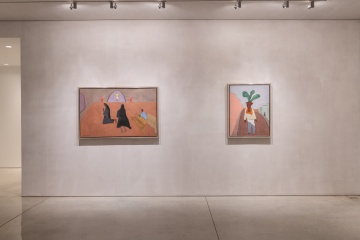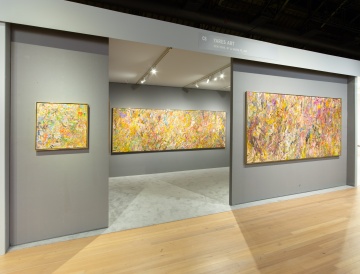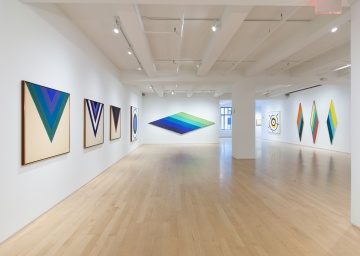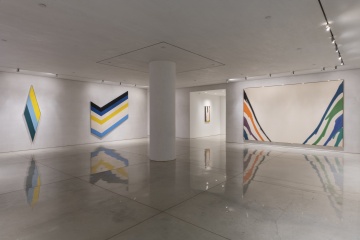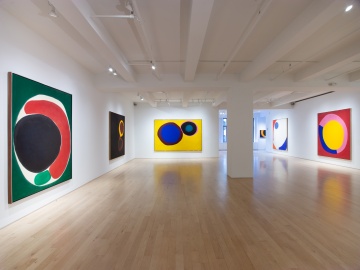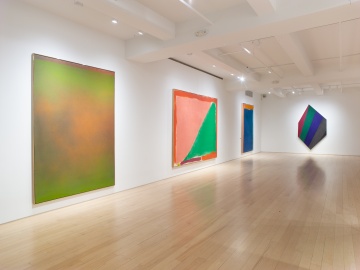Yares Art
479 Rodeo Drive
Beverly Hills, CA 90210
By Appointment
310 362 3464
Also at:
745 Fifth Avenue
New York, NY 10151
212 256 0969
1570 Pacheco Street, Suite A1
Santa Fe, NM 87505
Appointment Recommended
505 984 0044
Beverly Hills, CA 90210
By Appointment
310 362 3464
Also at:
745 Fifth Avenue
New York, NY 10151
212 256 0969
1570 Pacheco Street, Suite A1
Santa Fe, NM 87505
Appointment Recommended
505 984 0044
Yares Art was founded in 1964 by Riva Yares in Scottsdale, Arizona. In 1991 Yares Art established a second gallery in Santa Fe, NM. In 2016 the gallery opened its flagship venue in New York City. In 2019, Yares Art added 4000 square feet of exhibition space to its 5th Avenue NY location creating a combined 10000+ square feet of gallery space with six specific exhibition spaces. In 2023 Yares Art expanded to Beverly Hills, CA. The primary focus of the gallery over six decades is Abstract Expressionism paintings from the 1950s and 1960s, with a strong focus on the Color Field artists of that era.
Yares Art represents the estates of Thomas Downing, Friedel Dzubas, Joseph Marioni, Jules Olitski, and exclusively represents Larry Poons.
Yares Art publishes six catalogues and one book annually.
Yares Art has been a member of the ADAA for nearly 30 years and most recently participated in Art Basel, Art Basel Miami Beach, Art Basel Paris, The Art Show (ADAA), EXPO Chicago, TEFAF Maastricht, TEFAF New York.
Artists Represented:
Thomas Downing
Friedel Dzubas
Joseph Marioni
Jules Olitski
Larry Poons
Works Available By:
Arman
Milton Avery
Fletcher Benton
Ilya Bolotowsky
Byron Browne
Gene Davis
Thomas Downing
Friedel Dzubas
Helen Frankenthaler
Dorothy Fratt
Adolph Gottlieb
Hans Hofmann
Martin Horowitz
Penelope Krebs
Morris Louis
Howard Mehring
Joan Mitchell
Robert Motherwell
Manuel Neri
Kenneth Noland
Jules Olitski
Larry Poons
Rotraut
David Smith
Frank Stella
Esteban Vicente
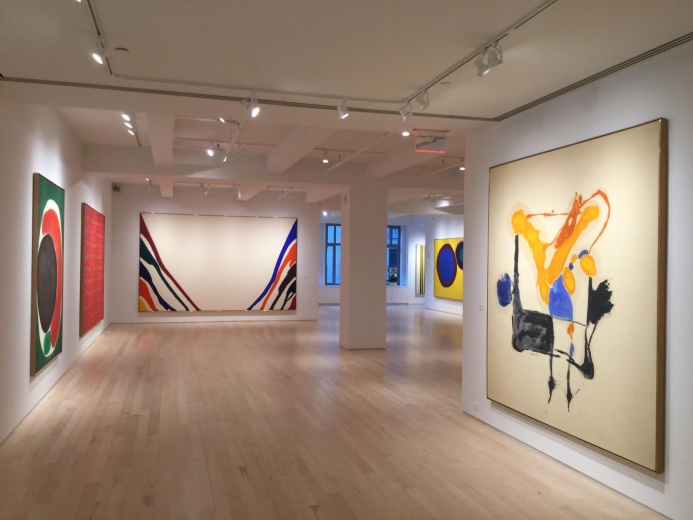
Installation view of Helen Frankenthaler + LMNOP. Courtesy of Yares Art, New York.
Jules Olitski
100 Paintings, 100 Years
October 1, 2022 - January 14, 2023
Kenneth Noland
Context is the Key
September 9, 2021 - January 22, 2022
Yares Art is pleased to present Kenneth Noland: Context is the Key, Paintings: 1968-1970, an exhibition of more than thirty works by one of the twentieth century’s most radical and influential American painters. The show focuses on abstract compositions that Noland produced from 1958 to 1970, which had a significant impact on the course of contemporary art. These compositions with bold, spare, captivating forms and sumptuous color relationships, emphasize the objecthood of the artwork and the flatness of the picture plane. At the time they were painted, Noland’s artworks were viewed as surprising and daring. Now widely acknowledged as classics of post-war abstraction, they are still as audacious and imposing as ever—and their influence may be observed today in the work of younger generations of artists.
Among the highlights of the show are examples of Noland’s most appreciated series of early large-scale works, including the Circles, Chevrons, Diamonds, and Stripes. Fete (1959), one of the artist's most iconic Circles, is composed of a precisely executed blue dot inside concentric bands of poured and splashed blue, yellow, and black paint emanating from hard-edge inner circles of white and blue. Pierced along the outer edge are five irregular, diagonal black lines. The work effectively bridges Abstract Expressionism with the then-nascent Color Field movement in painting, of which Noland was a principal leader. Half Time (1964), one of the artist's seminal Chevron paintings, depicts a green triangle and equivalent bands of purple, brown, red, and orange pressing from the top center toward the bottom of a blaring white field. The stark composition corresponds to the Minimalist aesthetic in avant-garde painting of the time.
Noland’s passion, however, lay in the various ways color can activate the surface of the canvas, even in its most lightly nuanced manifestations, as in the diamond-shaped canvas Datum (1966) with its four diagonal bands of analogous tones of blues and gray-greens. Five richly colored horizontal bands of equal proportions - with one extremely thin, almost silent band atop, stretching the entire length of Via Bound (1970) suggest a landscape reference within the abstract visual vocabulary that is unique to Noland.
Kenneth Clifton Noland was born in Asheville, North Carolina, in 1924. After serving in the Army Air Forces, he enrolled in the fabled Black Mountain College, where he studied with Bauhaus maestro Josef Albers, abstractionist Ilya Bolotowsky, architect Buckminster Fuller, and composer John Cage. Noland’s first New York solo show was held at the Tibor de Nagy gallery in 1957. Since then, his work has been the subject of numerous gallery and museum solo exhibitions worldwide. He died, age 85, at his home in Port Clyde, Maine, in 2010.
Noland participated in the 1964 Venice Biennale, and the Solomon R. Guggenheim Museum, New York, hosted his first retrospective in 1977, which traveled to the Corcoran Gallery of Art, Washington, DC, and the Toledo Museum of Art, Ohio.
His work is included in many of the world’s most prestigious museums, including the Albright-Knox Art Gallery, Buffalo; Art Institute of Chicago; Australian National Gallery, Canberra; Hirshhorn Museum and Sculpture Garden, Washington, DC; Kunstmuseum, Basel; Los Angeles County Museum of Art; Metropolitan Museum of Art, New York; Centre Georges Pompidou, Paris; Museum of Fine Arts, Boston; Museum of Modern Art, New York; Stedelijk Museum, Amsterdam; Tate Gallery, London; and Walker Art Center, Minneapolis, among numerous others.
Dorothy Fratt
Out of Washington
July 9, 2021 - October 2, 2021
YARES ART is pleased to present Dorothy Fratt: Out of Washington, on view in its Santa Fe venue, July 9 – October 2, 2021. This exhibition celebrates the unique achievements of Dorothy Fratt (1923–2017), an accomplished colorist, over the course of a long career beginning in 1947, and underscores her contribution to American abstract art.
Long associated with the Washington Color School, and sometimes identified as a key practitioner of Color Field painting, Fratt has been too often over-looked in surveys of these important movements. Although she avoided these labels, she nevertheless produced a singular body of work that advances the interrelationship of color and form, and the emotional potential of color in ethereal, abstract spaces. The artist’s vivid, masterfully wrought compositions evolve and unfold in this exhibition through a number of key examples, from the sensitively rendered figurative gouache After the Rodeo (1970), to the evocative abstract spaces in her mature works, such as Cousteau’s World (1973), with its expanses of aqua-blue, gold, and yellow. Another highlight of the show, Mummy Mountain (2002), is a spare composition with a searing orange-red ground punctuated with a touch of bright blue on the left, and, at center, an elongated “M” shape in an analogous red tone that suggests, via Fratt’s inimitable abstract language, a fiery mountain range, as indicated by the work’s title.
Born in Washington, DC, Fratt won multiple scholarships to Mount Vernon College, The Corcoran School of Art, and the Phillips Memorial Gallery of Art—all located in her native city. In 1958, the family moved to Phoenix, Arizona, where she offered private instruction in painting and color theory in her studio until 1972, and then on to Scottsdale where she continued her artistic practice and to lecture on art and color theory. One of her first major exhibitions was held at the Phoenix Art Museum in 1964. In 1990, she was the Key Note Speaker and panelist for the Sotheby’s Symposium on Quality in Art in New York City. Fratt received the Arizona Governor’s Award in 2000 for her contributions to the arts.
Fratt’s work may be found in the permanent collections of the New Mexico Museum of Art; Phoenix Art Museum; Museum of Northern Arizona, Flagstaff; Tucson Museum of Art; Scottsdale Museum of Contemporary Art; Hilliard Art Museum, Lafayette; Palm Springs Art Museum; Corcoran Gallery, Washington, DC; Städtische Galerie, Paderborn, Germany; and Museum Art. Plus, Donaueschingen, Germany.
Thomas Downing, Friedel Dzubas, Helen Frankenthaler, Adolf Gottlieb, Morris Louis, Kenneth Noland, Jules Olitski
Fields of Color III
April 10, 2021 - September 10, 2021
YARES ART is pleased to present Fields of Color III on view in New York, April 10 – July 31, 2021. This show brings together key works by the most prominent and influential leaders of the Color Field movement: Thomas Downing, Friedel Dzubas, Helen Frankenthaler, Adolf Gottlieb, Morris Louis, Kenneth Noland, and Jules Olitski. The nine radiant, large-scale, abstract works in Fields of Color demonstrate the unique visual, and also emotional, impact that the movement’s finest works can offer. Fields of Color III coincides with the exhibition Larry Poons / Frank Stella: As It Was, As It Is, concurrently on view in Yares Art’s adjacent fourth-floor gallery.
Among the exhibition’s high points, Morris Louis’s Gamma Iota (1960), an important example from his “Unfurled” series of mural-size canvases, shows four cascading bands of poured pigment emerging on each side of the raw canvas from the top, meandering toward the bottom center.The cool, fluid bands of blue, green, and turquoise unfurling on the right contrast with the earthier tones of black, orange, and purple of the left-side bands. The spare composition may suggest an image of ocean waves crashing against a steep hillside, although Louis’s work certainly remains rigorously abstract.
Towering figures of recent art history, Adolph Gottlieb and Helen Frankenthaler led the way from Abstract Expressionism to Color Field painting. Gottlieb is represented here by one of his signature “Burst” compositions, Pale Splash (1971), in which a hazy, dark orb at the top—suspended in a warm, rust-toned space—hovers above an energetic “burst” in pale pink. One of the most resplendent works of her long career, Frankenthaler’s Debussy (1992) features shimmering pools of cerulean and cobalt blue at left, complemented by richly textured passages of velvety greens and violet and pink, at the center and top right, respectively. Two of Kenneth Noland’s major Hard-edge works are also on view: Sky Island, (1969), a beautiful example of the artist’s horizontal stripes compositions, while the second, titled Crest (1967), is an iconic diamond-shaped canvas energized by three diagonal bands of deep blue, pale blue, and yellow. Side by side, sharing one entire wall with Crest to considerably dramatic effect, is Thomas Downing’s Fainting Angel, painted the same year, featuring hard-edge bands of similar hues.
In Friedel Dzubas’s First Run (1972), hazy, horizontal bands of bright color on the right collide with diagonal swaths of darker hues at left, dissolving into clouds of pale mist. Rounding out the exhibition, Jules Olitski’s Thursday (1962) and Yaksi Juice (1963) are monumental examples of the “Core” seriesof early Color Field works that established his reputation, and which were also the subject of Jules Olitski: Color to the Core, a landmark exhibition that opened at Yares Art last November.
Larry Poons, Frank Stella
As It Was, As It Is
March 20, 2021 - September 10, 2021
YARES ART is pleased to present Larry Poons / Frank Stella: As It Was, As It Is, on view in New York, March 20–July 31, 2021.This show brings together important historical and recent works by two legendary figures in contemporary American art. Frank Stella (b.1936) and Larry Poons (b.1937) came to the forefront of the avant-garde art scene in the same place, and at approximately the same time—New York City in the late 1950s and early 1960s. Like-minded spirits, and longtime friends, the two went on to electrify the art world in the second half of the twentieth century with unique visions and profoundly original works. Both artists to this day continue to share a passion for speed and racing—Poons, a racer of vintage motorcycles, and Stella lauded in the sport of auto-racing for his car designs for BMW and other companies.
Abstract Expressionist Barnett Newman was a major inspiration for both artists and encouraged their early hard-edge abstractions. Compositions, such as Poons’s Orange Crush (1963), and Stella’s Double Concentric Squares (1974)—among the highlights of the exhibition—offer alternatives to the Ab Ex and European art informel movements, which had dominated the international art world throughout the 1940s and ’50s. Eventually, the two artists moved away from hard-edge compositions toward more complex and fluid abstractions. Stella experimented with industrial materials, as he created dynamic painted-metal relief constructions throughout the 1970s and ’80s. Poons, meanwhile, explored the possibilities of color with radically innovative, ever evolving painting techniques over the next five decades.
From the 1960s onwards, the two have continued to praise and support each other’s art. In 1999, Stella wrote a complimentary catalogue essay, “Mr. Natural (Larry Poons),” and Poons has frequently expressed his admiration for Stella’s achievements. Larry Poons / Frank Stella: As It Was, As It Is offers a rare opportunity to see the works of these two stalwarts of contemporary art. On view are some twenty-six works, including a selection of early paintings along with each artists’ most recent works. Highlighted in the show are Stella’s recent small-scale sculptural maquettes centered on the “star” motif, a reference to the Italian translation of the artist’s last name. Some of these maquettes correspond to the large-scale works featured in the concurrent museum survey, Frank Stella’s Stars at the Aldrich Contemporary Art Museum, in Ridgefield, Connecticut (through May 9). A recent series of luminous square (24-by-24 inches) paintings by Poons, including Quiet as Spaces and Jarett (both 2019), are beautiful, concentrated compositions echoing his most recent large-scale paintings.
Frank Stella was born in Malden, Massachusetts. He studied at the Phillips Academy in Andover and graduated from Princeton University in 1958. He moved to New York soon after graduation, where he caused a stir with his proto-Minimalist “Black Paintings” that were shown at the Museum of Modern Art in 1959. He went on to develop his distinctive three-dimensional hybrid painted metal reliefs, which have been exhibited throughout the world. A major touring museum retrospective of his work, debuted at the Whitney Museum of American Art, October 30, 2015.
Larry Poons was born in Tokyo, Japan, to Anglo-American parents. He relocated with his family to the United States at a young age, and studied music composition at the New England Conservatory of Music in Boston. Recognizing his greater talent for visual art, he transferred to the School of the Museum of Fine Arts, Boston, where he studied painting. His career skyrocketed with the introduction of his originative “Dot paintings” soon after he moved to New York in the early 1960s.
Both artists are included in numerous prominent public and private art collections throughout the world, including the Albright- Knox Art Gallery, Buffalo; the Art Institute of Chicago; the Cleveland Museum of Art; the Hirshhorn Museum and Sculpture Garden, Washington, DC; the Metropolitan Museum of Art, New York; the Museum of Contemporary Art, Los Angeles; the Museum of Fine Arts, Boston; the Museum of Fine Arts, Houston; the Museum of Modern Art, New York; the Philadelphia Museum of Art; the Georges Pompidou Center, Paris the Santa Barbara Museum of Art; the Smithsonian American Art Museum, Washington, DC; the Tate Modern, London; the Van Abbemuseum, Eindhoven, Netherlands; the Whitney Museum of American Art, New York; and the Yale University Art Gallery, New Haven, among other institutions.
Larry Poons / Frank Stella: As It Was, As It Is is accompanied by a fully illustrated catalogue with an essay by Alex Bacon.
Jules Olitski
Color to the Core
November 7, 2020 - March 12, 2021
After a rewarding and unparalled relationship with Jules Olitski that lasted over forty years, and, more recently, in the championing of his legacy, Yares Art is honored to announce that it will assume the exclusive representation of the artist’s Estate in the United States. On this occasion, Jules Olitski: Color to the Core: Paintings 1960-1964 celebrates the artist’s work and underscores this lasting collaboration.
Nearly a century after his birth in 1922, Yares Art pays homage to the legendary artist with a show of his groundbreaking works from the early 1960s. These large-scale abstract compositions—often referred to as the “Core” paintings—feature imposing, rudimentary shapes in brilliant colors that emanate from monochrome backgrounds of dark or dramatically contrasting hues. The works of this period, which also anticipated the later famous “Spray” Paintings of the later 1960s and ’70s, were the first to bring Olitski national recognition.
Among the exhibition’s many highlights, Fanny D (1960) centers on a group of four irregular, circular shapes in turquoise, yellow, blue, and black, set against a mauve background. The lively orbs appear to be nestled within a wide circular band whose plush pink tone contributes to the work’s intensely sensuous color. Also on view, Lucy’s Fancy and Basium Blush (both 1960) are classic examples of the period, in which large cellular shapes in bright colors, trimmed in bands of contrasting hues dominate the centers of the canvases. They deliver an almost super- graphic visual charge. In each work, the circular forms appear to press against all sides of the canvas, as if the painting’s rectangular format can barely contain their energy.These magnetic works are among the early experiments in abstract painting that came to be known as Color Field Painting, a movement for which Olitski is internationally renowned, and still regarded today as one of its principal and most influential leaders.
Jules Olitski was born Jevel Demikovsky, March 27, 1922, in Snovsk, Soviet Russia, (now Ukraine), a few months after his father, a commissar in the army, was executed by the Soviet government. He immigrated to the United States in 1923 with his mother and grandmother and settled in Brooklyn. In 1926, his mother married Hyman Olitsky, a widower with two sons. A daughter was born in 1930. (The “y” became an “i” in 1951 when it was misspelled on an exhibition announcement). An exhibition at the 1939 New York World’s Fair, featuring works by Rembrandt, inspired Olitski to become an artist. In 1940, he was admitted to the National Academy of Design in New York and, in the evenings, he attended the Beaux Arts Institute from 1940 to 42.
Olitski served in the army during World War II, after which he settled in New York. In 1949, he moved to France on the G.I. Bill where he studied at the Ossip Zadkine School and the Académie de la Grande Chaumière in Paris. There, the artist held his first one-person show at Galerie Huit in 1951. Olitski returned to New York in May of that year and received his BA from New York University in 1952. Six years later, in 1958, his first New York solo exhibition opened at the Zodiac Room, Alexander Iolas Gallery’s contemporary art space. During this time, he met critic Clement Greenberg, who subsequently invited him to participate in a group show at French & Company. In 1961, he was invited to participate in the Pittsburgh International Exhibition of Contemporary Painting and Sculpture where he was awarded a prize, garnering further recognition of his work.
Olitski taught at Bennington College in Vermont from 1963 to 1967, and during his tenure there, in 1966, the artist represented the United States in the 33rd Venice Biennale alongside Helen Frankenthaler, Roy Lichtenstein, and Ellsworth Kelly. The following year, he won the Corcoran Gold Medal when his work was shown at the 30th Biennial Exhibition of Contemporary American Painting at The Corcoran Gallery of Art, Washington, DC. Remarkably, in 1969, Olitski became the first living American artist to be given a one-person exhibition at the Metropolitan Museum of Art, where he exhibited large spray-painted aluminum sculptures. He was inducted into the Academy of Arts and Letters in 2006, and he was awarded the prestigious Skowhegan Award for Painting in 2007. Olitski exhibited extensively both nationally and inter- nationally throughout his career, and he resided between New Hampshire and Florida for the last three decades of his life until his death in 2007 at age 84.
Jules Olitski’s works are included in the permanent collections of major museums, including the Albright Knox Art Gallery, Buffalo, NY; Art Gallery of Ontario, Toronto, Ontario, Canada; Art Institute of Chicago, IL; Brooklyn Museum, NY; Cincinnati Art Museum, Cincinnati, OH; Dallas Museum of Art, TX; Detroit Institute of the Arts, MI; Solomon R. Guggenheim Museum, New York, NY; Hirshhorn Museum and Sculpture Garden, Washington, DC; The Kemper Museum, Kansas City, Mo; The Metropolitan Museum of Art, New York, NY; Museum of Art, Seoul, Korea; Museum of Modern Art, New York, NY; Museum of Contemporary Art, Los Angeles, CA; Museum of Contemporary Art, Miami, FL; Museum of Fine Arts, Boston, MA; Museum of Fine Arts, Houston, TX; Museum Moderner Kunst Stiftung Ludwig, Vienna, Austria; National Gallery of Art, Washington, DC; The Nelson-Atkins Museum of Art, Kansas City, MO; The Phillips Collection, Washington, DC; Princeton University Art Museum, Princeton, NJ; San Francisco Museum of Modern Art, CA; Tate Modern, London, England; Wadsworth Atheneum, Hartford, CT; Walker Art Center, Minneapolis, MN; Whitney Museum of American Art, New York, NY; and Yale University Art Gallery, New Haven, CT; among numerous other public institutions.
Jules Olitski, Color to the Core, Paintings:1960-1964 is accompanied by a fully illustrated catalogue with essays by Alexander Nemerov and Patricia Lewy, and an introduction by David Ebony.
Milton Avery, Gene Davis, Thomas Downing, Friedel Dzubas, Helen Frankenthaler, Dorothy Fratt, Adolph Gottlieb, Hans Hofmann, Morris Louis, Howard Mehring, Robert Motherwell, Kenneth Noland, Jules Olitski, Larry Poons
Leap of Color
February 29, 2020 - July 25, 2020
YARES ART is pleased to present Leap of Color, an in-depth exploration of the Ab-Ex/Color Field movement from its inception inthe mid-1950s to recent works. On view are major paintings by celebrated artists who are widely regarded as key figures in the evolution, development, and refinement of the field: MILTON AVERY, GENE DAVIS,THOMAS DOWNING, FRIEDEL DZUBAS, HELEN FRANKENTHALER, DOROTHY FRATT, ADOLPH GOTTLIEB, HANS HOFMANN, MORRIS LOUIS, HOWARD MEHRING, ROBERT MOTHERWELL, KENNETH NOLAND, JULES OLITSKI, and LARRY POONS, among other celebrated artists of the era.
Leap of Color allows artists, art historians, and all art audiences to examine the close personal, professional and aesthetic connections and confluences of these modern and contemporary masters. Early on, beginning in the 1930s, Milton Avery, who never strayed from figuration, was a mentor to Adolph Gottlieb and a number of other leading artists of Abstract Expressionism. Ab-Ex pioneer Hans Hofmann inspired younger artists to experiment with color, as did Ab-Ex luminary Robert Motherwell, partner of Helen Frankenthaler’s in art and life for over a decade. With her staining techniques and exuberant allover compositions, Frankenthaler has been credited with launching Color Field painting, and with great influence on the development of the Washington Color School in DC.
Leap of Color highlights the work of Color Field innovator Morris Louis, whose Number 9 (1961) on view is a resplendent example of his “Stripes” series. Also featured are top-notch examples by other Washington Color School greats, such as Gene Davis, Thomas Downing, Dorothy Fratt, Howard Mehring, and Kenneth Noland, whose shaped canvas of 1977, Blind Passage, expands the possibilities for Color Field painting, as do radiant works by New York artists Jules Olitski and Larry Poons. All of the artists in the exhibition share an adventurous spirit and the ability to offer the viewer a singular, immersive experience of light and color.
Milton Avery, Sally Avery, March Avery, Sean Cavanaugh
The Family Avery
February 26, 2020 - March 1, 2020
Although the paintings of Sean Cavanaugh sometimes flirt with the photographic - so convincing is their illusionism - they are, for all their veracity, as abstract as the art of his forbears: his grandfather, Milton Avery, grandmother, Sally Michel, and mother, March Avery. One might say that the primary concern of the Avery family art enterprise, while individually arrived at, is the transformation of the raw data of the physical world into its abstract equivalents. This way of thinking about artmaking dates back at least to the time of Paul Cezanne: first the artist receives his or her impression of the motif (be it the landscape outside of Aix-en-Provence or the hills near Woodstock, New York); then, suspicious of the mere aping of realtiy, the artist searches for a visual language - constructed of line, shape, and color - that can translate the original sensation into a commensurately intense feeling for the spectator. For the Averys, this process has always been nearly somatic, something like breathing in and out, even if the means of bridging the gap between apprehending the world and turning it into art has changed with the times. Milton, for instance began as a plein air painter, who, along with his gifted wife Sally, made studies - usually in pencil or watercolor - that later served as reference points for oil paintings; their daughter March followed suit, but in addition to on-site drawings and watercolors, she employs photographs as memory-aids in the making of her work; her son Sean, in turn, bases his oil paintings on the photographs he takes as his starting point, whether in Hawaii, Montana, or the south of France. What binds three generations of Avery artists, irrespective of medium or working method, is their bedrock belief in art as modernist alchemy, the miraculous turning of subjective experience into objective poetic fact.
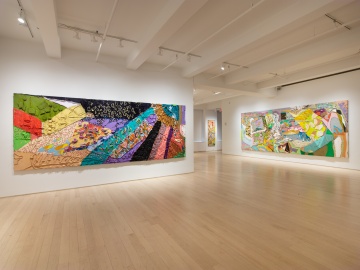
Larry Poons
"First Thought, Best Thought" - The Particle Paintings
November 9, 2019 - December 21, 2019
YARES ART is pleased to present Larry Poons: First Thought, Best Thought —The Particle Paintings (1996–2002) on view in New York, November 9–December 21, 2019. In addition to his “Particle Paintings,” the exhibition will also feature a selection of Poons’s most recent works (2018–2019).
This show highlights the rarely exhibited and spectacular panoramic compositions Larry Poons produced from the mid-1990s through the early 2000s—which echo author Allen Ginsberg’s “First Thought, Best Thought” motto through their apparent spontaneity. This will be the first exhibition in Yares Art’s newly expanded galleries to focus exclusively on this exceptional period of Poons’s oeuvre, offering the public a unique opportunity to discover paintings that count among the artist’s most imaginative, brilliant, yet underrecognized achievements.
In the 1960s, Poons reached critical success at an early age for his iconic “Dots” and “Lozenges” paintings—hard-edge, abstract compositions that placed the artist at the forefront of American painting. Ever the restless innovator, Poons subsequently abandoned hard-edge abstraction to refine a technique in the 1970s and ’80s centered on pouring and throwing paint, resulting in his famed “Throw” paintings, where elements of chance and gravity play major roles in the creative process.
By the early 1990s, a different aesthetic, exemplified in the “Particle” paintings, had emerged. The artist created his “Particle” paintings by attaching onto the canvas bits and chunks (i.e. “particles”) of various items, such as foam, rubber, polyester fiber, and other various raw materials. These elements slowed down the flow of the paint creating a radical visual alteration from his earlier “Throw” paintings.
During the mid-1990s, Poons started to draw shapes and lines on raw canvas, pre-determining a general composition, which he would subsequently fill up with “particles” and eventually paint. The underlying “particles” became more pronounced, and acted as part of an elaborate “under-drawing” in each composition, blurring the lines between abstraction and representation. Poons gradually abandoned his paint-throwing technique, and instead began to apply the paint directly onto the raw canvas and “particles” with brushes—or, at times, even his hands. The luxuriant surfaces in works such as From Life’s Other Side and Sinistra (both 1996), appear almost as sculptural reliefs, with drop shadows indicating hyperactive networks of lines and shapes.
Though fundamentally abstract, the resultant images suggest epic narratives with nuanced allusions to landscape, interior spaces, and an often personal iconography—such as musical notation, hinting at the artist’s early ambitions in musical composition. Vibrant works such as The Compression Sisters (1998), and In Assisi (2000), encompass rhythmic arrangements of staccato lines and searing colors, reminiscent of works by American modernist painter Stuart Davis, one of the heroes of Poons’s youth.
Also during the 1990s, Larry Poons and his wife Paula traveled the country extensively to participate in motorcycle races—remarkably, his brightly colored “Particle” Paintings often suggest enhanced interpretations of the American landscape. Many paintings on view, including Arizona and Utah (both 1997) were painted in a temporary outdoor studio in Islamorada, where Poons was deeply inspired by the tropical landscape and brilliant sunlight of Florida.
Born in Tokyo in 1937 to American parents, Poons relocated with his family to the United States at a young age, where he later studied music composition at the New England Conservatory of Music in Boston. Recognizing his greater talent for visual art, he transferred to the School of the Museum of Fine Arts, Boston, where he studied painting. His career skyrocketed soon after he moved to New York in the early 1960s.
Larry Poons’s work is included in many prominent public and private art collections throughout the world, including the Albright-Knox Art Gallery, Buffalo; the Art Institute of Chicago; the Cleveland Museum of Art; the Hirshhorn Museum and Sculpture Garden, Washington, DC; the Metropolitan Museum of Art, New York; the Museum of Contemporary Art, Los Angeles; the Museum of Fine Arts, Boston; the Museum of Fine Arts, Houston; the Museum of Modern Art, New York; the Philadelphia Museum of Art; the Georges Pompidou Center, Paris the Santa Barbara Museum of Art; the Smithsonian American Art Museum, Washington, DC; the Tate Modern, London; the Van Abbemuseum, Eindhoven, Netherlands; the Whitney Museum of American Art, New York; and the Yale University Art Gallery, New Haven, among other institutions.
Larry Poons:“First Thought, Best Thought”/The Particle Paintings is accompanied by a fully illustrated catalogue with an essay by Alex Bacon, and an introduction by David Ebony, co-author, along with Barbara Rose and Karen Wilkin, and David Anfam of Larry Poons a forthcoming monograph published by Abbeville Press.
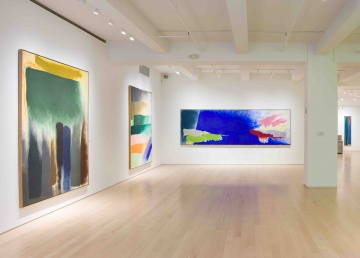
Friedel Dzubas
Affective Color
September 14, 2019 - November 2, 2019
YARES ART is pleased to present Friedel Dzubas: Affective Color, on view in New York, September 14-November 2, 2019. This exhibition, featuring major works by one of the seminal figures referred to under the rubric “Color Field” or “Post Painterly Abstractionists,” marks a special event for Yares Art as it also inaugurates the gallery's expansion to a new additional exhibition space across the hall (formerly the Mary Boone Gallery). Dzubas often worked in large scale to create expansive, panoramic compositions; the combined gallery spaces allow Yares Art to offer a rare, full-view presentation of this artist's remarkable achievement. The show features a fine example of his early, Abstract Expressionist-related works of the 1950s, through to his exquisite, signature paintings from the 1960s onward—immersive compositions with luminous soft-edge geometric shapes activating colorful, ethereal spaces, all realized by means of distinctive, bravura brushwork that is uniquely Dzubas.
One of the most ambitious twentieth-century abstract painters, Dzubas (1915-1994) is also perhaps the most traditional, particularly in the matter of his adherence to historic painterly techniques, with a special focus on the fresco painting of the late Baroque/Rococo master Giovanni Battista Tiepolo. The passionate brushwork and the complex color relationships Dzubas favored in canvases such as First Run (1972), Blue Round (1973), and Coat of Arms (1982)—among the highlights of the show—both approach and reflect the celestial brilliance of Tiepolo's work. Mural-size paintings by Dzubas, such as Procession (1975), another exhibition high point, with its rhythmic arrangement of vertical and horizontal rectangular forms, echo the epic scale and the lofty ambition of the best eighteenth-century painters in search of divine light and sublime space. Dzubas was born in Berlin in 1915 and was classified as a Mischling, a person of so-called mixed-race, as the son of a Jewish father and Catholic mother. Early on, he faced hurdles to his artistic education both from his practical-minded father, as well as from the state, which restricted full Jews as well as Mischling access to the Prussian Academy of Fine Arts.
On the eve of World War II, Dzubas immigrated to the United States, settling first in Virginia before moving to New York in 1941. Championed by the renowned critic Clement Greenberg, he met Jackson Pollock and many other Abstract Expressionists, becoming in 1948 a member of The Club, along with a coterie of artists that included Willem de Kooning, Franz Kline, and Ad Reinhardt, among others. Dzubas shared a studio with Helen Frankenthaler in 1952, and his work of the period was included in numerous group exhibitions along with that of his likeminded peers. During this same year, his well-received solo debut at Tibor de Nagy was the start of a long and illustrious career. An influential teacher as well as an esteemed artist, Dzubas taught for some years at Cornell University and the School of the Museum of Fine Arts, Boston. A career retrospective of his work was held in 1983 at the Hirshhorn Museum and Sculpture Garden, Washington, D.C. He died in Newton, Massachusetts, in 1994. Dzubas's works are held in numerous prominent public and private collections throughout the world. These include the Metropolitan Museum of Art and the Whitney Museum of Art, New York; The Hirshhorn Museum and Sculpture Garden, Washington D.C.; the Museum of Fine Arts, Houston; the Israel Museum, Jerusalem, the Art Gallery of Alberta, Edmonton.

Sean Cavanaugh
Under The Elder's Gaze
August 2, 2019 - September 28, 2019
YARES ART is pleased to present Sean Cavanaugh: Under the Elder's Gaze, an exhibition of recent works centered on intimate nature studies. The show appears at YARES ART, Santa Fe, August 2-September 28, 2019. Highlighted here are approximately two dozen of Cavanaugh's precisionist oil-on-canvas paintings and luminous works on paper featuring detailed renderings of trees. Cavanaugh's meticulously wrought compositions are often intimate in scale but expansive and powerful in scope and ambition.
"Often trees are the oldest living members of the environment, and some are the oldest life forms on Earth," the artist noted in a recent statement. "It is my hope that my work expresses some measure of their presence, quiet wisdom, and beauty." Cavanaugh's sensitive and astute approach to nature studies conveys an increasing sense of urgency today, as the natural environment becomes ever more threatened by recent attempts to reverse environmental protections throughout this country and abroad.
Due to the artist's commanding technical ability, a botanist would be able to easily recognize the various species of trees that Cavanaugh focuses on in his work. However, with his subtle and stunning nuances of tone and texture, Cavanaugh's work, on some level, advances the possibilities of pure painting. The painterly aspect of his endeavor is befitting an artist who grew up surrounded by paintings-those of his mother March Avery, and his grandparents Sally and Milton Avery-all artists whose work reflects a special reverence for nature. Born in 1969, Cavanaugh received a Bachelor of Arts degree in both art and environmental studies from Pitzer College in Claremont, California. Having developed his own inimitable painting style over the years, Cavanaugh has held numerous solo gallery and museum exhibitions throughout the country, most recently at the Lowe Art Museum, University of Miami, Coral Gables, Florida.
Sean Cavanaugh
August 2, 2019 - September 28, 2019

Fletcher Benton
A-Z
June 7, 2019 - June 27, 2019
YARES ART is pleased to present FLETCHER BENTON: A to Z, on view in Santa Fe, June 7–July 27, 2019. This extraordinary exhibition surveys and honors the long and distinguished career of Fletcher Benton, an iconic American sculptor. The Ohio-born, California-based artist, now 87, burst upon the art scene in the 1960s with a series of kinetic sculptures incorporating elements of light that were among the most advanced experiments in sculpture of the day. He went on to produce remarkable abstract compositions in metal that were, and remain today, powerful visual statements that are both elegant and intellectually engaging.
On view in the exhibition are some sixty major works that span Benton’s six-decade career. Many pieces on view have never been shown in New York, offering the rare opportunity to reassess the achievement of one of the country’s most inventive and consistently challenging artists, whose formidable contribution to contemporary art has been recognized internationally.
Among the show’s highlights are the provocative kinetic works from his “Synchronetic” series, which early on in his career brought him critical acclaim. The mesmerizing orchestrations of light and shadow, as well as the evolving movement, inherent in these pieces have connected him with the West Coast Light & Space movement.
Also on view are the sophisticated, thematic “Alphabet” sculptures, whose exuberant geometry addresses issues of language and abstraction in a novel and colorful way. In addition, the graceful compositions in steel, such as the monumental Stainless Steel Donut No. 5 (2012), and a number of various series are included in the exhibition, relating to Benton’s numerous commissions for large-scale public pieces. These works demonstrate the meticulous, innovative craftsmanship, which has been a hallmark of the artist’s work throughout his career.
Born in Jackson, Ohio, in 1931, Benton studied at the Miami University in Oxford, Ohio. In 2008, he was the recipient of the Lifetime Achievement in Sculpture Award from the International Sculpture Center, Hamilton, New Jersey. He currently lives and works in San Francisco, California.
Benton’s work is included in many prominent public and private art collections throughout the world, including the Hirshhorn Museum and Sculpture Garden, Washington, DC; the Los Angeles County Museum of Art; the San Francisco Museum of Modern Art; the Metropolitan Museum of Art, New York; and the Whitney Museum of American Art, New York.
Fletcher Benton is accompanied by a fully illustrated catalogue with an essay by David Ebony.
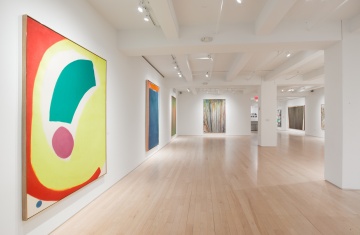
Jack Bush, Gene Davis, Friedel Dzubas, Helen Frankenthaler, Hans Hofmann, Penelope Krebs, Morris Louis, Howard Mehring, Robert Motherwell, Kenneth Noland, Jules Olitski, Larry Poons, Frank Stella, Theodoros Stamos, Esteban Vicente, Jack Youngerman
Fields of Color II
May 25, 2019 - August 23, 2019
YARES ART is pleased to present Fields of Color II, an exhibition of major Color Field works, on view in New York, May 25 - August 23, 2019.
Presenting works by Morris Louis, Kenneth Noland, Jules Olitski, and Helen Frankenthaler, innovative artists who used pouring and staining techniques in expansive compositions that changed the course of twentieth-century painting. Also on view are works by contemporary artists, including Larry Poons and Penelope Krebs, who continue to redefine Color Field and expand the expressive possibilities of abstract painting today. Featured in this exhibition are important examples of paintings by Hans Hofmann, the Abstract Expressionist maestro, whose works such as Opulence (1954) and Setting Sun (1957), included in the show, had a lasting impact on the Color Field painters.
Rounding out the roster of celebrated Color Field classics are Gene Davis, Friedel Dzubas, Howard Mehring, and Thomas Downing. Among the show's many highlights are Louis's 1961 "Stripe" painting, Third Element; Olitski's brilliant Z (1964), with a magenta orb and a dramatic band of green pulsating against a searing yellow ground; and Poons's panoramic Hunch (2018). At nearly five-by-twenty-five feet, this resplendent work is one of the largest and most spellbinding compositions that the artist has created. With a tour-de-force of painterly acumen, Poons presents an arresting play of color, light, and movement that offers a vital link between Color Field's history and future, a fitting denouement of the exhibition Fields of Color II.
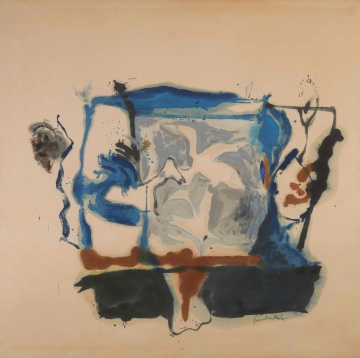
Helen Frankenthaler
Selected Paintings
March 2, 2019 - May 18, 2019
YARES ART is pleased to present HELEN FRANKENTHALER: SELECTED PAINTINGS, on view in New York, March 2-May 18, 2019. Helen Frankenthaler (1928-2011) is one of the most important and influential postwar painters, whose abstract compositions, featuring brilliant ex-panses of color and light, have inspired generations of artists and changed the course of art history. Through her pioneering work of the early 1950s—large-scale compositions made with innovative pouring and staining techniques—she led the way from Abstract Expressionism to a new and vital form of painterly lyricism that heralded the Color Field movement.
On view in this exhibition are some twenty major large-scale paintings that celebrate the New York-born artist’s formidable, six-decade career. A classic Frankenthaler work, Swan Lake II (1961), filled with ethereal pools of electric blue, grays, and deep red, against a neutral ground, is a quint-essential example of her unparalleled achievement. Among the show’s other highlights is Pavillion (1971) and Summer Core (1968), both mural-size compositions featuring Frankenthaler’s distinctive, celestial blue tones. Here, the artist explores spatial relationships and the role of color in the composition’s overall emotional impact. In subsequent works, including Closing the Gap (1979), with infinite fields of Venetian red punctuated with touches of orange and lavender; and December Start, showing misty gray clouds traversed by a sensuous passage of pale pink, the artist offers painting a wholly immersive experience. Though fundamentally abstract, other works in the show, such as Las Mayas (1958) alluding to the works of Goya and Scarlatti (1987) to those of Tiepolo, convey a reverence for the lessons of the Old Masters.
A legendary figure who rose to art-world prominence at an early age, Frankenthaler studied with Paul Feeley and Hans Hofmann. She knew personally most of the Abstract Expressionist greats, including Jackson Pollock, Franz Kline, and Robert Motherwell, to whom she was married from 1958 to 1971. Painted when she was just twenty-three, Mountains and Sea (1952), her first publically exhibited work, now in the collection of the National Gallery of Art, Washington, DC, is widely regarded as a milestone in the history of art. She had embraced Pollock’s method of painting on the floor and his pouring techniques, but used them for a very different purpose. From early on in her career, she conveyed a meditative and spiritual reverence for nature rather than simply a self-reflective psychological investigation. Frankenthaler thus developed her own esoteric visual language that is universally understood today.
Frankenthaler’s work is included in many prominent public and private art collections throughout the world, including the Albright-Knox Art Gallery, Buffalo, New York; Art Gallery of Ontario, Toronto, Canada; The Art Institute of Chicago, Illinois; Auckland Art Gallery, New Zealand; The Baltimore Museum of Art, Maryland; Bennington College, Vermont; Berkeley Art Museum and Pacific Film Archive, University of California, Berkeley; Carnegie Museum of Art, Pittsburgh, Pennsylvania; The Cleveland Museum of Art, Ohio; Dallas Museum of Art, Texas; Hirshhorn Museum and Sculpture Garden, Smithsonian Institution, Washington, DC; The Israel Museum, Jerusalem; The Metropolitan Museum of Art, New York; Musée National d’Art Moderne, Centre Pompidou, Paris, France; The Museum of Modern Art, New York; Museum of Fine Arts, Boston, Massachusetts; National Gallery of Art, Washington, DC; The National Gallery of Australia, Canberra; Philadelphia Museum of Art, Pennsylvania; The Phillips Col-lection, Washington, DC; San Francisco Museum of Modern Art, California; Seattle Art Museum, Washington; Singapore Art Museum; Solomon R. Guggenheim Museum, New York; Tate, London, United Kingdom; Victoria and Albert Museum, London, United Kingdom; Walker Art Center, Minneapolis, Minnesota; Wallraf-Richartz-Museum & Fondation Corboud, Cologne, Germany; Whitney Museum of American Art, New York; Yale University Art Gallery, New Haven, Connecticut.
HELEN FRANKENTHALER: SELECTED PAINTINGS is accompanied by a fully illustrated catalogue with an essay by Alexander Nemerov.
All artworks © 2019 Helen Frankenthaler Foundation, Inc. / Artists Rights Society (ARS), New York

Fletcher Benton
A to Z
January 19, 2019 - February 24, 2019
YARES ART is pleased to present FLETCHER BENTON: A to Z, on view in New York, January 19-February 24, 2019. This extraordinary exhibition surveys and honors the long and distinguished career of sculptor Fletcher Benton, an iconic American sculptor. The Ohio-born, California-based artist, now 87, burst upon the art scene in the 1960s with a series of kinetic sculptures incorporating elements of light that were among the most advanced experiments in sculpture of the day. He went on to produce remarkable abstract compositions in metal that were, and remain today, powerful visual statements that are both elegant and intellectually engaging.
On view in the exhibition are some sixty major works that span Benton's six-decade career. Many pieces on view have never been shown in New York, offering the rare opportunity to reassess the achievement of one of the country's most inventive and consistently challenging artists, whose formidable contribution to contemporary art has been recognized internationally.
Among the show's highlights are the provocative kinetic works from his "Synchronetic" series, which early on in his career brought him critical acclaim. The mesmerizing orchestrations of light and shadow, as well as the evolving movement, inherent in these pieces have connected him with the West Coast Light & Space movement.
Also on view are the sophisticated, thematic "Alphabet" sculptures, whose exuberant geometry addresses issues of language and abstraction in a novel and colorful way. In addition, the graceful compositions in steel, such as the monumental Stainless Steel Donut No. 5 (2012), and a number of various series are included in the exhibition, relating to Benton's numerous commissions for large-scale public pieces. These works demonstrate the meticulous, innovative craftsmanship, which has been a hallmark of the artist's work throughout his career.
Born in Jackson, Ohio, in 1931, Benton studied at the Miami University in Oxford, Ohio. In 2008, he was the recipient of the Lifetime Achievement in Sculpture Award from the International Sculpture Center, Hamilton, New Jersey. He currently lives and works in San Francisco, California.
Benton's work is included in many prominent public and private art collections throughout the world, including the Hirshhorn Museum and Sculpture Garden, Washington, DC; the Los Angeles County Museum of Art; the San Francisco Museum of Modern Art; the Metropolitan Museum of Art, New York; and the Whitney Museum of American Art, New York.
Fletcher Benton is accompanied by a fully illustrated catalogue with an essay by David Ebony.
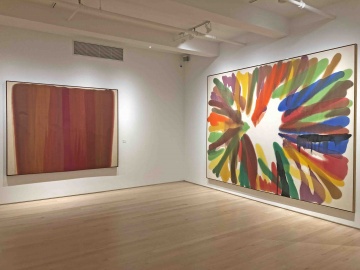
Morris Louis
Spectrum
November 3, 2018 - January 12, 2019
YARES ART presents MORRIS LOUIS: SPECTRUM on view in New York, November 3, 2018 - January 12, 2019.The exhibition features a selection of major works by Morris Louis (1912-1962), one of the most renowned and influential abstract painters of the twentieth century, whose work continues to inspire new generations of artists and collectors. In a career spanning less than a decade, shortened by the artist's untimely death, the Washington, DC-based artist expanded the boundaries of abstract painting by creating mural-scale compositions with infinite spaces and pure, translucent color. The sumptuous canvases in this exhibition envelop and enrapture viewers with the mysterious and ethereal luminosity characteristic of Louis's work. On view here are iconic examples from all of Louis's most celebrated series, including "Veils," "Stripes," "Unfurled," and "Themes and Variations."
During his lifetime, Louis was known and respected by a small group of critics, curators, collectors, and likeminded artists, including Kenneth Noland and Helen Frankenthaler. Louis's fame, though, is largely posthumous. In the 1950s, until the time of his death, he worked in a small dining room he converted into a studio in his suburban home. Despite the confining make-shift studio, he experimented with pouring and staining techniques on vast swaths of canvas, averaging 8 1.2 by 12 feet. Dramatically divergent from the Abstract Expressionist works that dominated the era, Louis eschewed gestural and textural markings, as well as vestiges of expressive imagery; instead, he aimed toward a purity of vision in terms of composition, color, and light. Monumental in more than one sense, these works eventually came to be recognized as among the pinnacle achievements of the Color Field movement.Today, Louis's vast legacy continues to grow.
Among the highlights of the show is Green Shade (1958), a quintessential "Veil" painting, with thin layers of deep green and gray-green pigment covering a large (91 by 134 3.4-inches) canvas. While wholly abstract, the imposing yet gentle cascade suggests the sea-foam mist of a crashing ocean wave. Among other outstanding works, Number 9, a major-scale "Stripe," features tall, vertical lines of brilliant color-blue, yellow, green, red, and orange-sequestered on each side by the unprimed white canvas. More meditative, but similarly riveting, Beta Gamma is a resplendent example of Louis's "Unfurled" series. Here, on each side of the canvas, diagonal, narrow bands of poured, incandescent color frame a vast central expanse of unadulterated canvas-the inimitable and sublime space that this artist so poignantly articulates.
Born Morris Louis Bernstein in Baltimore, Maryland, in 1912, to Russian émigré parents, the artist attended Baltimore's Maryland Institute of Fine and Applied Arts (now the Maryland Institute College of Art [MICA]). In 1954, Louis traveled to New York, where he was included in a well-received New York group show organized by critic Clement Greenberg. Louis's work garnered greater attention from museum curators and collectors after being featured in a 1957 group exhibition at New York's prestigious Leo Castelli Gallery. Just as his career was about to be firmly established, Louis succumbed to lung cancer in early 1962, and died, age 49, on September 7th of that year. The following year, his first major solo museum exhibition was held posthumously at the Solomon R. Guggenheim.
Morris Louis's work is included in many prominent public and private art collections throughout the world, including the Metropolitan Museum of Art, Solomon R. Guggenheim Foundation, Museum of Modern Art, and Whitney Museum of American Art, New York; Los Angeles County Museum of Art;The Art Institute of Chicago; Saint Louis Art Museum; Museum of Fine Arts, Boston; Baltimore Museum of Art; High Museum of Art, Atlanta; Hirshhorn Museum and Sculpture Garden, Washington, DC; Museum of Fine Arts, Houston; the Philadelphia Museum of Art; the Louisiana Museum of Art, Denmark; National Gallery, Berlin; Museum Ludwig, Cologne;The Stedelijk Museum, Amsterdam; Museo National Centro de Arte, Reina Sofia, Madrid; Tel Aviv Museum of Art, Israel; and The National Museum of Modern Art,Tokyo.
Morris Louis: Spectrum is accompanied by a fully illustrated catalogue with an introduction by Diane Upright, and an essay by Alexander Nemerov.
Thomas Downing
Spot On
November 1, 2018 - January 31, 2019
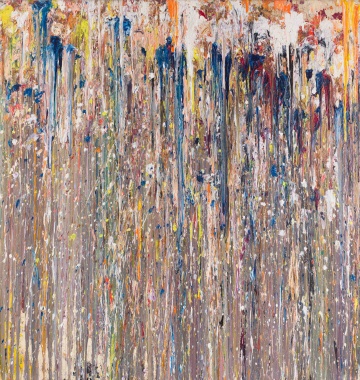
Larry Poons
Ruffles Queequeg + The Throw Decade 1971-1981
September 15, 2018 - October 27, 2018
YARES ART is pleased to present Larry Poons: Ruffles Queequeg + The Throw Decade Paintings: 1971–1981, on view in New York, September 15– October 27, 2018.The show’s unusual title refers to a character in Herman Melville’s Moby Dick, as well as to a pivotal painting in the oeuvre of one of America’s most important and influential artists, Larry Poons. A highlight of the exhibition, Ruffles Queequeg (1972) heralded Poons’s reemergence on the international art scene in the early 1970s as one of the most dynamic and significant leaders of the Color Field movement. While still in his twenties, Poons achieved considerable success and renown in the 1960s for abstract compositions, in the then-new medium of acrylic paint, featuring hard-edge colorful dots and lozenge shapes that pulsate against backgrounds of contrasting hues. One of the most inventive—and restless—artists of his generation, Poons heroically fought against the demands of art-world expectations and moved his art forward to explore novel techniques, processes, and materials. With the “throw” paintings, which preoccupied him throughout the 1970s, he arrived at a lush and sensuous realm of painterly expression that had never been seen before.
The artist’s second solo exhibition at Yares Art, New York, includes large-scale canvases, such as Johnson (1973), No More Greasy Boots Allowed in Here (1975), Rain of Terror, and Lycoming (both 1977), all masterful examples of the period.These works confront the viewer with innumerable cascades of pigment in countless hues. In his initial violent act of painting—throwing buckets of paint toward the top of the canvas and allowing the drips to flow down at will—the artist enlists as his accomplices in these works the laws of chance as well as gravity.With an insistent verticality, the compositions create hypnotic, and often meditative, optical effects that are not dissimilar from those found in Poons’s earlier dots and lozenge compositions.
Ever changing and evolving, Poons, in subsequent decades, continued to experiment with new approaches and processes.The exhibition also includes a selection of his most recent works, such as Pictures in the Closet and Duco Walk (both 2018), painted with brushes and fingers.These luminous canvases prove that still at eighty years old, Poons continues to refine his extraordinary vision and redefine the possibilities of painting. As ever, his works challenge and impress audiences with their inimitable play of color, light, and movement.
Born inTokyo in 1937 to Anglo-American parents, Poons relocated with his family to the United States at a young age, and studied music composition at the New England Conservatory of Music in Boston. Recognizing his greater talent for visual art, he transferred to the School of the Museum of Fine Arts, Boston, where he studied painting. His career skyrocketed soon after he moved to New York in the early 1960s.
Larry Poons’s work is included in many prominent public and private art collections throughout the world, including the Albright-Knox Art Gallery, Buffalo; the Art Institute of Chicago; the Cleveland Museum of Art; the Hirshhorn Museum and Sculpture Garden, Washington, DC; the Metropolitan Museum of Art, New York; the Museum of Contemporary Art, Los Angeles; the Museum of Fine Arts, Boston; the Museum of Fine Arts, Houston; the Museum of Modern Art, New York; the Philadelphia Museum of Art; the Georges Pompidou Center, Paris; the Santa Barbara Museum of Art; the Smithsonian American Art Museum,Washington, DC; the Tate Modern, London; the Van Abbemuseum, Eindhoven, Netherlands; the Whitney Museum of American Art, New York; and the Yale University Art Gallery, New Haven, among other institutions.
Larry Poons: Ruffles Queequeg + The Throw Decade Paintings: 1971–1981, is accompanied by a fully illustrated catalogue with an introduction by Michael Fried and essays by Alex Bacon and Frank Stella.

Milton Avery
Early Works On Paper + Late Paintings
July 6, 2018 - September 22, 2018
YARES ART is pleased to present Milton Avery: Early Works on Paper and Late Paintings, on view in Santa Fe, July 6-September 22, 2018. Milton Avery (1885-1965) is a towering figure in twentieth-century art, whose reputation grows more illustrious with each passing year. He developed a unique visual vocabulary inspired in part by European modernism while wholly embracing the American vernacular. Over the years, his work has inspired generations of artists-abstract and figurative painters alike.
This extraordinary exhibition features some twenty large-scale oil paintings, including a number of Avery's most acclaimed land- and seascape compositions that he produced late in his career. Complementing these remarkable paintings are about fifty rarely exhibited works on paper from the 1930s, which demonstrate the artist's mastery of watercolor and gouache early in his career. The exhibition presents many well- known works from prominent collections, as well as a number of pieces being shown in Santa Fe for the first time. Among the rarely exhibited gems on view is Hills and Sunset Sky (1964), a luminous masterwork that is the last major painting that Avery completed.
Celebrating fifty years of representing the artist's estate, Yares Art is proud to present the gallery's first comprehensive Milton Avery exhibition at its Santa Fe location, after having premiered at its recently established New York venue. Among the many highlights of the show are celebrated masterworks such as the stunning, large-scale marine images Rolling Surf (1958) and Sails in Sunset Sea (1960), which are widely regarded as among Avery's best works.
The seascape motif was a favorite for Avery since early in his career. His beach scenes from the 1930s encompass a subtle social commentary in striking pieces such as Swimmers and Beach Scene; featuring crisp line and luminous color, these images depict working-class people enjoying leisure time at the seashore.
Avery never created completely abstract works, but his subtly nuanced landscapes and figurative compositions, especially his late paintings, often approach abstraction. He was a mentor to the Abstract Expressionists, including Adolph Gottlieb and Mark Rothko, and led the way to Color Field painting with the novel tonal play and quietly daring spatial relationships that are important attributes of Avery's oeuvre.
During his lifetime he was renowned as an "artist's artist," as he incorporated the language of abstraction into a singular exploration of the figure, landscape, and still life. His work remains fresh, vibrant and more relevant than ever for contemporary art today.
Milton Avery: Early Works on Paper and Late Paintings is accompanied by a catalogue with essays by noted scholars and critics Eliza Rathbone, William C. Agee, and David Ebony.
For further information, please contact:
Manuel Garcia: mg@yaresart.com; (505) 984-0044
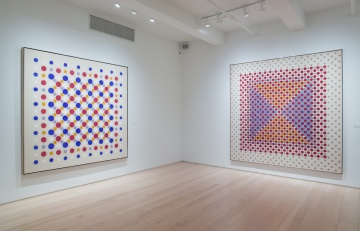
Thomas Downing
Spot On
May 12, 2018 - August 6, 2018
YARES ART is pleased to present Thomas Downing: Spot On, a major exhibition on view in New York, May 12 - August 6, 2018. American artist Thomas Downing (1928-1985) created an extraordinary body of work in the 1960s and '70s, featuring large-scale abstract compositions of pulsating patterns of colorful dots. Born in Suffolk, Virginia, Downing studied at the Pratt Institute in New York. He became a leader of the Washington Color School, or as it is often referenced, the Washington, DC, Color Field Movement. Downing, along with artist colleagues including Morris Louis, Gene Davis, Helen Frankenthaler, Howard Mehring, and Kenneth Noland (his teacher and mentor), experimented with expansive abstractions, often using staining techniques, to create immersive and transcendental realms of color and light.
Downing's unique contribution to twentieth-century art consists of mesmerizing canvases filled with precise arrangements of dots in varying sizes and tonal values. In his series "Dial," "Grid," and "Dot" paintings, Downing produced evocative abstract images that suggest movement as well as an infinite space founded on rigorous, mathematically based geometric systems. Downing's work however is intuitive, intense, and highly expressive, rather than coldly formulaic, as his meticulous process might imply. The handmade nature of Downing's work, the paintings' subtle irregularities revealed in the sprays and faint haloes from soaked paint around his circular shapes and in the grids, solidify the idea that the effects of structure and color were more important to him than precise execution.
This extraordinary exhibition features over eighteen major paintings that are among the best of Downing's career. Thomas Downing: Spot On is accompanied by a fully illustrated catalogue with essays by noted writers Raphael Rubinstein and Mollie R.Berger, and an introduction by David Anfam, that situate Downing's work within the context of the turbulent era of the 1960s, with its progressive experiments in psychology and science, as well as the work's relevance and importance within the contemporary arts scene today.
Thomas Downing's work is held in major museum collections, including the National Gallery of Art, Washington, DC; The Whitney Museum of American Art, New York; the Norton Simon Museum, Pasadena; the Phillips Collection Washington, DC; and the San Francisco Museum of Modern Art.
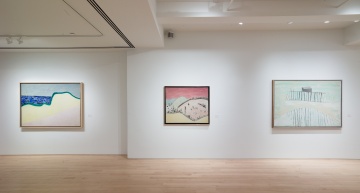
Milton Avery
Early Works on Paper + Late Paintings
February 24, 2018 - April 30, 2018
YARES ART is pleased to present Milton Avery: Early Works on Paper and Late Paintings, on view in New York, February 24–April 30, 2018. Milton Avery (1885-1965) is a towering gure in modern twentieth-century art, with an illustrious and celebrated career that spanned over ve decades. He developed a unique visual vocabulary inspired in part by European modernism while wholly embracing the American vernacular. Over the years, his work has inspired generations of artists—abstract and gurative painters alike.
This extraordinary exhibition features over twenty major-scale oil paintings, including a number of Avery’s most acclaimed landscape, seascape, and gurative compositions that he produced late in his career. Complementing these remarkable oil paintings are fty never-before exhibited works on paper from the 1930s, which demonstrate the artist’s mastery of watercolor and gouache early in his career.The exhibition presents many well-known works from prominent private and public collections, as well as a number of pieces being shown in New York for the rst time. Among the rarely exhibited paintings on view is Hills and Sunset Sky (1964), a luminous masterwork that is the last major painting that Avery completed.
Celebrating fty years of representing the artist’s estate,Yares Art is proud to present the gallery’s rst Milton Avery exhibition at its recently established New York venue. Among the many highlights of the show are celebrated masterworks such as Dunes and Sea II (1960) from the collection of the Whitney Museum of American Art. Other powerful and engaging marine images here, such as Rolling Surf (1958) and Sails in Sunset Sea (1960), are widely regarded as among Avery’s best works.
The seascape motif was a favorite for Avery since early in his career. His beach scenes from the 1930s encompass a subtle social commentary in striking pieces such as Untitled (Yellow Swimsuit) and Untitled (Four on the Sand); featuring crisp line and luminous color, these images depict working-class people enjoying leisure time at the seashore.
Avery never created completely abstract works, but his subtly nuanced landscapes and gurative compositions, especially his late paintings, often approach abstraction. He was a mentor to the Abstract Expressionists, including Adolph Gottlieb and Mark Rothko, and led the way to Color Field painting with the novel tonal play and quietly daring spatial relationships that are important attributes of Avery’s oeuvre.
During his lifetime he was renowned as an “artist’s artist,” as he incorporated the language of abstraction into a singular exploration of the gure, landscape, and still life. His work remains fresh, vibrant, and more relevant than ever for contemporary art today.
Milton Avery: Early Works on Paper and Late Paintings is accompanied by a catalogue with essays by noted scholars and critics Eliza Rathbone, William C. Agee, and David Ebony.

Fields of Color
January 13, 2018 - February 17, 2018

 Back to all Member Galleries
Back to all Member Galleries







